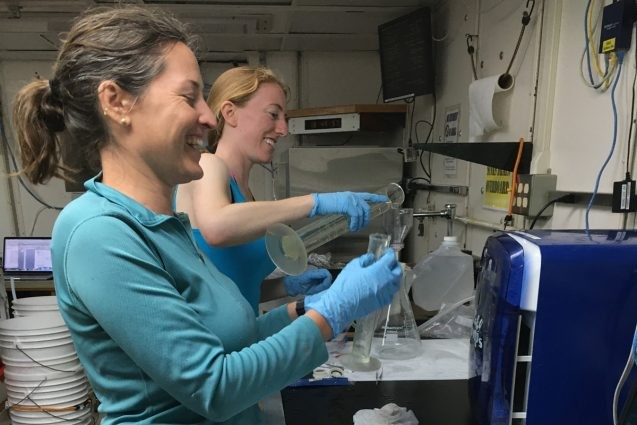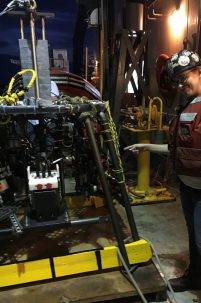Shipboard Science: It’s All About Collaboration This Week
Early-career scientists aboard the UNOLS training cruise are getting to try new techniques and technologies, and collaborations are springing up everywhere.

By Bridgit Boulahanis
Most of the year, marine geophysicists are indoor creatures—we can usually be found in our labs, working with data on our computers. This research cruise is different, because, while data collection is always a scientist’s prime directive in the field, this cruise has the added goal of training early career researchers to use the wide variety of tools and techniques represented on board.
That objective is what led to me leaning over the edge of the ship at 2:30 a.m., using a hook at the end of a very long pole to pull a gigantic camera platform onto the deck. The more we learn about how other researchers’ science is conducted, the more broadly skilled we become. Being early in our careers was a prerequisite to joining the University-National Oceanographic Laboratory System (UNOLS) Deep-Submergence Science Leadership Cruise, so every participant is eager to learn new techniques and find opportunities for collaboration.

The mentors are shining examples of how teamwork across disciplines leads to more exciting science. Dan Fornari, a senior scientist in geology and geophysics at Woods Hole Oceanographic Institution, built the camera platform I was reeling in. It had been entirely re-purposed a few hours earlier. Dan’s research focuses on the seafloor, and the platform was designed for his projects, but when the scientists studying the water column began discussing ways to collect more samples, Dan stepped up. Over the course of a couple of hours, he attached extra cameras, removed seafloor sampling devices, and added a few lights to facilitate the study of the tiny particles floating in seawater. It was ready for water column sampling.
Interdisciplinary work was happening all over the ship. I spent much of the afternoon helping researchers transfer water from sampling bottles recently pulled from the ocean into large jugs. I was nervous, but Amanda Netburn, a pelagic ecologist at NOAA, assured me that there was no way I would mess up pouring water from one container to another.
As we filled the water bottles, we discussed our fields’ various sampling techniques. Our research couldn’t be more different—I study the rocks under the ocean; Amanda studies the fish swimming in it. Her cruises involve a large net being dipped well below the ocean surface and dragged behind the ship in order to catch a few fish that she will study. My research requires instruments pulled behind the ship that blow giant bubbles, which send sound waves through the earth that are recorded on specially designed microphones, telling us information about the rock layers below. We have plenty in common, though. We talked about how both of our fields once used dynamite—hers to catch fish, mine to create sound waves (both practices ended long ago, and we discussed the much better techniques and technology used today)—and we both want to increase human understanding of the planet we call home.
This cruise is important because of all of the great data we are collecting, but it is the learning and connections being made aboard that will serve the participants for many years to come. Collaborations are springing up between diverse fields, and everyone has learned new sampling techniques for future scientific endeavors. No matter what scientific discoveries come out of this cruise, the training aspect is already an unmitigated success.
Bridgit Boulahanis is a marine geophysics graduate student at Columbia University’s Lamont-Doherty Earth Observatory. Her research utilizes multichannel seismic reflection and refraction studies as well as multibeam mapping data to explore Mid-Ocean Ridge dynamics, submarine volcanic eruptions, and how oceanic crustal accretion changes through time. Read more about the training cruise in her first post.
Save
